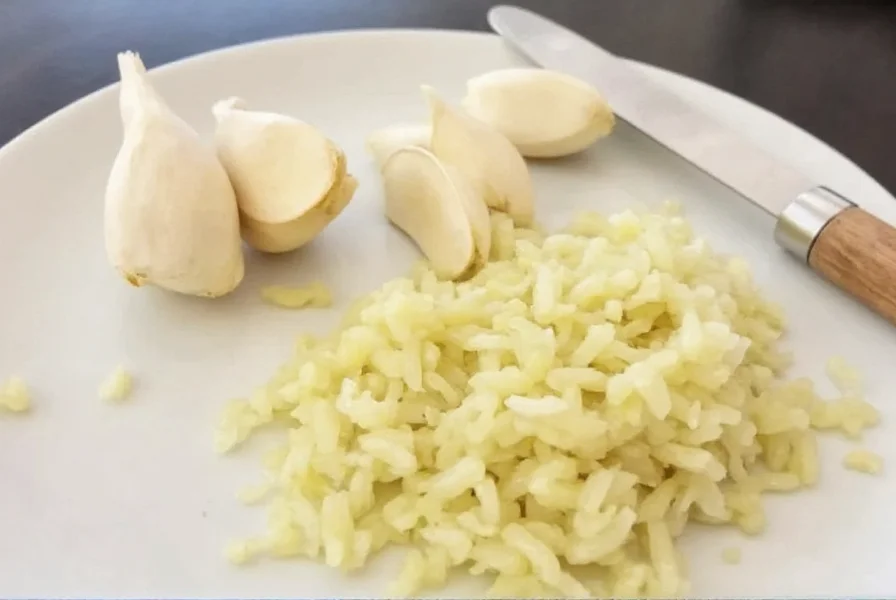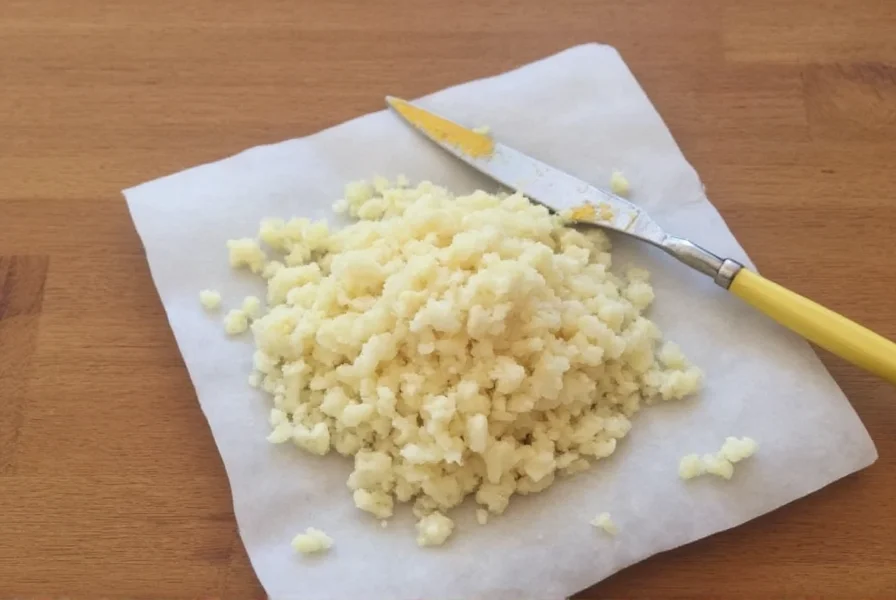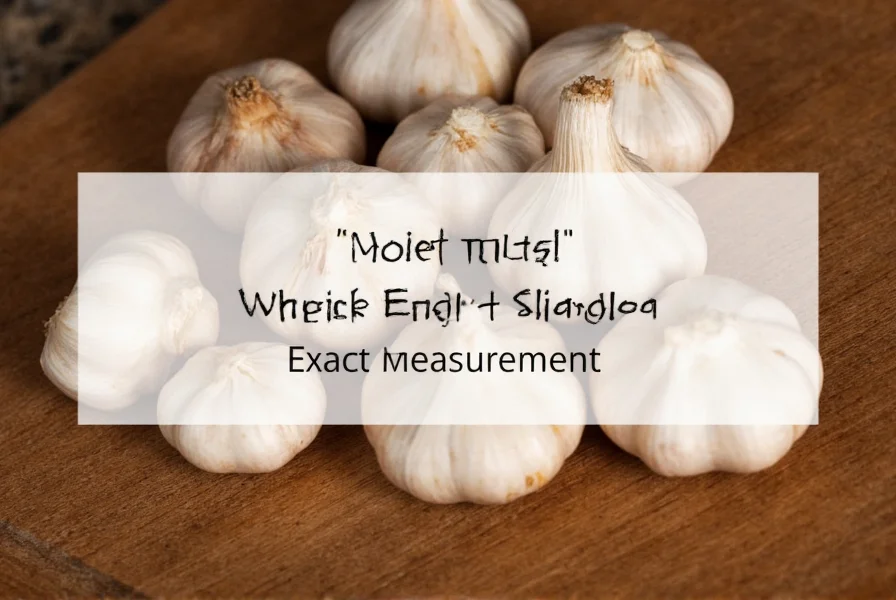Understanding garlic measurements is crucial for home cooks and professional chefs alike. When a recipe calls for minced garlic but you're working with whole cloves, knowing the exact conversion ensures your dishes achieve the intended flavor profile without overpowering or under-seasoning.
Standard Garlic Measurement Conversion
The relationship between whole garlic cloves and their minced equivalent follows a consistent pattern based on average clove size. Culinary professionals and recipe developers use standardized measurements to maintain recipe consistency across different kitchens.
| Whole Garlic Cloves | Minced Garlic Equivalent | Finely Minced Equivalent |
|---|---|---|
| 1 small clove | ½ teaspoon | ¼ teaspoon |
| 1 medium clove | 1 teaspoon | ½ teaspoon |
| 1 large clove | 1½ teaspoons | ¾ teaspoon |
| 2 medium cloves | 2 teaspoons (⅔ tablespoon) | 1 teaspoon |
| 3 medium cloves | 1 tablespoon | 1½ teaspoons |
Factors Affecting Garlic Measurement Accuracy
Several variables influence the precise conversion from whole cloves to minced garlic:
Clove Size Variability
Garlic cloves vary significantly in size depending on the variety and growing conditions. Standard conversions assume medium-sized cloves (approximately 1 inch long and ½ inch in diameter). Smaller or larger cloves will yield proportionally less or more minced garlic.
Mincing Technique Matters
Your mincing method affects the final volume:
- Hand-minced: Produces slightly larger pieces that pack less densely
- Food processor: Creates finer mince that compacts more, potentially yielding slightly less volume
- Garlic press: Produces the most compact minced garlic, about 20% less volume than hand-minced
Moisture Content Differences
Freshly harvested garlic contains more moisture than cured garlic, affecting both weight and volume when minced. For precise baking applications, weight measurements (grams) provide more consistency than volume measurements.

Practical Cooking Applications
Knowing how much minced garlic is equivalent to 2 cloves helps you adapt recipes confidently. When substituting:
- For most savory dishes, use the 1:1 teaspoon per medium clove ratio as your baseline
- In delicate sauces or dressings, consider using slightly less minced garlic as the flavor distributes more evenly
- When roasting whole cloves, remember they mellow significantly—minced raw garlic provides a sharper flavor profile
Recipe Conversion Tips
If your recipe specifies "2 cloves garlic, minced" but you're using pre-minced garlic from a jar:
- Measure 2 teaspoons of jarred minced garlic
- Reduce by ¼ teaspoon if the garlic appears particularly moist
- Add gradually, tasting as you go, since preserved garlic can have intensified flavor
Storage Considerations for Minced Garlic
Understanding how many teaspoons is 2 garlic cloves minced becomes especially valuable when preparing garlic in advance. Proper storage maintains quality:
- Homemade minced garlic keeps for 7-10 days refrigerated in an airtight container
- Add a small amount of olive oil to prevent drying (use within 5 days)
- Freeze minced garlic in ice cube trays for longer storage (up to 3 months)
- Jarred minced garlic typically contains preservatives that extend shelf life but may alter flavor

When Precision Really Matters
Certain culinary applications demand exact garlic measurements:
- Baking: In breads and savory pastries where chemical reactions occur
- Preserving: When making garlic-infused oils or vinegars for shelf stability
- Professional recipe development: For consistent results across multiple test kitchens
- Dietary restrictions: For individuals sensitive to garlic's compounds
For these situations, consider weighing your garlic. Two medium cloves typically weigh 10-12 grams, yielding 5-6 grams of minced garlic after accounting for moisture loss during preparation.
Common Measurement Mistakes to Avoid
Cooks often make these errors when converting 2 cloves garlic equals how much minced:
- Not accounting for clove size variations between grocery store batches
- Measuring minced garlic too tightly packed in the spoon
- Forgetting that roasted garlic yields less volume than raw when minced
- Using dried garlic powder without adjusting for its concentrated flavor
Remember that garlic intensity varies by season and origin. When in doubt, start with slightly less than the standard conversion and adjust to taste—especially important when working with the question of how much minced garlic from 2 cloves in unfamiliar recipes.
Frequently Asked Questions
How many tablespoons is 2 cloves of minced garlic?
Two medium garlic cloves yield approximately 2 teaspoons of minced garlic, which equals ⅔ tablespoon. Remember that clove size affects this conversion—large cloves may yield up to 1 tablespoon while small cloves might only produce ½ tablespoon.
Can I substitute garlic powder for 2 cloves of minced garlic?
Yes, but use ⅛ teaspoon of garlic powder per clove as a starting point. For 2 cloves, begin with ¼ teaspoon garlic powder and adjust to taste. Garlic powder is more concentrated (about 3:1 ratio compared to fresh), so add gradually and allow time for flavors to develop in your dish.
Does the conversion change if I use a garlic press?
Yes, using a garlic press typically yields about 20% less volume than hand-mincing because it compacts the garlic more thoroughly. For 2 cloves, you'll get approximately 1½ teaspoons instead of the standard 2 teaspoons. The flavor intensity remains similar, but the texture differs significantly.
How much jarred minced garlic equals 2 fresh cloves?
Use 1½-2 teaspoons of jarred minced garlic to replace 2 fresh cloves. Jarred garlic often contains preservatives and has a slightly different moisture content, so start with 1½ teaspoons, taste, and add more if needed. Remember that jarred garlic tends to have a more intense flavor than freshly minced.
Why does my recipe call for minced garlic instead of whole cloves?
Recipes specify minced garlic when even flavor distribution is crucial. Minced garlic releases its compounds more quickly and thoroughly than whole cloves, creating a more integrated flavor profile. Whole cloves are typically used when you want pockets of intense garlic flavor or when roasting, as they mellow significantly during cooking.











 浙公网安备
33010002000092号
浙公网安备
33010002000092号 浙B2-20120091-4
浙B2-20120091-4